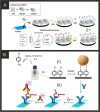Electroanalytical point-of-care detection of gold standard and emerging cardiac biomarkers for stratification and monitoring in intensive care medicine - a review
- PMID: 35279780
- PMCID: PMC8917829
- DOI: 10.1007/s00604-022-05186-9
Electroanalytical point-of-care detection of gold standard and emerging cardiac biomarkers for stratification and monitoring in intensive care medicine - a review
Abstract
Determination of specific cardiac biomarkers (CBs) during the diagnosis and management of adverse cardiovascular events such as acute myocardial infarction (AMI) has become commonplace in emergency department (ED), cardiology and many other ward settings. Cardiac troponins (cTnT and cTnI) and natriuretic peptides (BNP and NT-pro-BNP) are the preferred biomarkers in clinical practice for the diagnostic workup of AMI, acute coronary syndrome (ACS) and other types of myocardial ischaemia and heart failure (HF), while the roles and possible clinical applications of several other potential biomarkers continue to be evaluated and are the subject of several comprehensive reviews. The requirement for rapid, repeated testing of a small number of CBs in ED and cardiology patients has led to the development of point-of-care (PoC) technology to circumvent the need for remote and lengthy testing procedures in the hospital pathology laboratories. Electroanalytical sensing platforms have the potential to meet these requirements. This review aims firstly to reflect on the potential benefits of rapid CB testing in critically ill patients, a very distinct cohort of patients with deranged baseline levels of CBs. We summarise their source and clinical relevance and are the first to report the required analytical ranges for such technology to be of value in this patient cohort. Secondly, we review the current electrochemical approaches, including its sub-variants such as photoelectrochemical and electrochemiluminescence, for the determination of important CBs highlighting the various strategies used, namely the use of micro- and nanomaterials, to maximise the sensitivities and selectivities of such approaches. Finally, we consider the challenges that must be overcome to allow for the commercialisation of this technology and transition into intensive care medicine.
Keywords: Biosensor; Cardiac biomarkers; Critically ill; Electroanalysis; Electrochemistry; Intensive care; Nanomaterial.
© 2022. The Author(s).
Conflict of interest statement
The authors declare no competing interests.
Figures










Similar articles
-
Troponin T or troponin I or CK-MB (or none?).Eur Heart J. 1998 Nov;19 Suppl N:N16-24. Eur Heart J. 1998. PMID: 9857934
-
Aptasensor-based point-of-care detection of cardiac troponin biomarkers for diagnosis of acute myocardial infarction.Kaohsiung J Med Sci. 2025 Mar;41(3):e12932. doi: 10.1002/kjm2.12932. Epub 2025 Jan 3. Kaohsiung J Med Sci. 2025. PMID: 39749782 Free PMC article. Review.
-
A Randomized Trial of a 1-Hour Troponin T Protocol in Suspected Acute Coronary Syndromes: The Rapid Assessment of Possible Acute Coronary Syndrome in the Emergency Department With High-Sensitivity Troponin T Study (RAPID-TnT).Circulation. 2019 Nov 5;140(19):1543-1556. doi: 10.1161/CIRCULATIONAHA.119.042891. Epub 2019 Sep 3. Circulation. 2019. PMID: 31478763 Clinical Trial.
-
Rule-out of non-ST elevation myocardial infarction by five point of care cardiac troponin assays according to the 0 h/3 h algorithm of the European Society of Cardiology.Clin Chem Lab Med. 2018 Mar 28;56(4):649-657. doi: 10.1515/cclm-2017-0486. Clin Chem Lab Med. 2018. PMID: 29257750
-
Nanomaterial-based biosensors and immunosensors for quantitative determination of cardiac troponins.J Pharm Biomed Anal. 2018 Sep 10;159:425-436. doi: 10.1016/j.jpba.2018.07.031. Epub 2018 Jul 18. J Pharm Biomed Anal. 2018. PMID: 30041152 Review.
Cited by
-
Progress in the Optical Sensing of Cardiac Biomarkers.Biosensors (Basel). 2023 Jun 7;13(6):632. doi: 10.3390/bios13060632. Biosensors (Basel). 2023. PMID: 37366997 Free PMC article. Review.
-
Electrochemical Immunosensor for the Quantification of Galectin-3 in Saliva.Sens Actuators B Chem. 2024 Feb 1;400(Pt B):134811. doi: 10.1016/j.snb.2023.134811. Epub 2023 Oct 19. Sens Actuators B Chem. 2024. PMID: 38046365 Free PMC article.
-
Triple Enhancement for Sensitive Immunochromatographic Assay: A Case Study for Human Fatty Acid-Binding Protein Detection.Biosensors (Basel). 2022 Dec 14;12(12):1166. doi: 10.3390/bios12121166. Biosensors (Basel). 2022. PMID: 36551132 Free PMC article.
-
Aptamers Targeting Cardiac Biomarkers as an Analytical Tool for the Diagnostics of Cardiovascular Diseases: A Review.Biomedicines. 2022 May 6;10(5):1085. doi: 10.3390/biomedicines10051085. Biomedicines. 2022. PMID: 35625822 Free PMC article. Review.
-
Imprinted Hydrogel Nanoparticles for Protein Biosensing: A Review.ACS Sens. 2023 Aug 25;8(8):2898-2920. doi: 10.1021/acssensors.3c01010. Epub 2023 Aug 9. ACS Sens. 2023. PMID: 37556357 Free PMC article. Review.
References
-
- McLean AS, Huang SJ, Nalos M, Tang B, Stewart DE. The confounding effects of age, gender, serum creatinine, and electrolyte concentrations on plasma B-type natriuretic peptide concentrations in critically ill patients. Crit Care Med. 2003;31:2611–2618. doi: 10.1097/01.CCM.0000094225.18237.20. - DOI - PubMed
Publication types
MeSH terms
Substances
LinkOut - more resources
Full Text Sources
Medical
Research Materials
Miscellaneous
